In response to a tractor-trailer rollover that triggered a collision of a motorcoach, the National Transportation Safety Board this week reiterated safety recommendations made in September 2008 to counteract the effects of fatigued commercial drivers and to reduce the occurrence of fatigue in the first place.
The crash that sparked NTSB’s recommendations occurred just before 2 a.m. on Oct. 16, 2005. A tractor-trailer traveling westbound on Interstate 94 near Osseo, Wis., departed the right-hand lane and traveled along the earthen roadside before re-entering the highway where it overturned, coming to rest on its right side and blocking both westbound lanes.About a minute later, a chartered 55-passenger motorcoach, carrying members of a high school band and traveling at highway speeds, crashed into the underside of the overturned truck. The crash killed the motorcoach driver and four passengers, while 35 passengers and the truck driver received minor-to-serious injuries.
NTSB on Monday, Feb. 2, wrote letters to Rose A. McMurray, acting deputy administrator of the Federal Motor Carrier Safety Administration, and Ronald Medford, acting deputy administrator of the National Highway Traffic Safety Administration. The letters reiterated NTSB’s Sept. 16, 2008, recommendations that:
NTSB also reiterated its previous recommendation that NHTSA complete a rulemaking on adaptive cruise control and collision warning system performance standards for new commercial vehicles. Those standards should address obstacle detection distance, timing of alerts, and human factors guidelines, such as the mode and type of warning, NTSB said.










